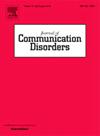Prosody and gestures help pragmatic processing in children with Developmental Language Disorder
IF 2.1
3区 医学
Q2 AUDIOLOGY & SPEECH-LANGUAGE PATHOLOGY
引用次数: 0
Abstract
The combination of linguistic prosody and bodily signals help typically developing children (TD) in accessing pragmatic meanings. We investigated the benefits of prosodic and gestural cues for processing pragmatic meanings in children with Developmental Language Disorder (DLD), having difficulties with structural language and pragmatics. 34 children with DLD and 45 TD controls, aged 5 to 10, participated in two visual-world eye-tracking tasks on pragmatic meanings that varied in complexity and develop in different stages: interrogative meaning (Exp. 1, less complex, developing earlier) and indirect requests (Exp. 2, more complex, developing later). In both experiments we manipulated the cues highlighting the intended meaning (prosodically-enhanced, multimodally-enhanced, and no-enhancement). The results showed that all children benefited from prosodic- and multimodal-enhancement to comprehend less complex meanings developing earlier, that younger children with DLD were less accurate even if such cues were present, and that the multimodal-enhancement was especially helpful for children with DLD when processing more complex meanings at an older age. Eye gaze data in both experiments revealed that, compared to TD children, children with DLD showed less clear preference to look at the Target image after the unfolding of bodily and prosodic cues, but that multimodal cues did reduce the children's bias to look at the literal interpretation of indirect requests. Our results highlight the importance of prosodic and bodily cues for the processing of pragmatic meanings that vary in complexity, especially when linguistic abilities are impaired, and have important implications on the communicative strategies that professionals use with children with DLD.
韵律和手势有助于发展性语言障碍儿童的语用处理
语言韵律和身体信号的结合有助于正常发育儿童获取语用意义。我们研究了韵律和手势线索对结构语言和语用学有困难的发展性语言障碍(DLD)儿童语用意义加工的益处。34名5 ~ 10岁的DLD儿童和45名对照组儿童参与了两项视觉世界眼动追踪任务,研究了不同复杂程度和发展阶段的语用意义:疑问句意义(实验1,较不复杂,发展较早)和间接请求意义(实验2,较复杂,发展较晚)。在这两个实验中,我们都对提示进行了操作,以突出预期的含义(韵律增强、多模态增强和无增强)。结果表明,所有儿童都受益于韵律和多模态增强,以理解较早发展的较不复杂的意义,年龄较小的DLD儿童即使存在这些线索,也不太准确,多模态增强对年龄较大的DLD儿童在处理更复杂的意义时特别有帮助。两个实验中的注视数据都显示,与TD儿童相比,DLD儿童在身体和韵律线索展开后,对目标图像的偏好不那么明显,但多模态线索确实减少了儿童对间接请求的字面解释的偏好。我们的研究结果强调了韵律和身体线索对于复杂的语用意义加工的重要性,特别是当语言能力受损时,这对专业人员对DLD儿童使用的交际策略具有重要意义。
本文章由计算机程序翻译,如有差异,请以英文原文为准。
求助全文
约1分钟内获得全文
求助全文
来源期刊

Journal of Communication Disorders
AUDIOLOGY & SPEECH-LANGUAGE PATHOLOGY-REHABILITATION
CiteScore
3.30
自引率
5.90%
发文量
71
审稿时长
>12 weeks
期刊介绍:
The Journal of Communication Disorders publishes original articles on topics related to disorders of speech, language and hearing. Authors are encouraged to submit reports of experimental or descriptive investigations (research articles), review articles, tutorials or discussion papers, or letters to the editor ("short communications"). Please note that we do not accept case studies unless they conform to the principles of single-subject experimental design. Special issues are published periodically on timely and clinically relevant topics.
 求助内容:
求助内容: 应助结果提醒方式:
应助结果提醒方式:


